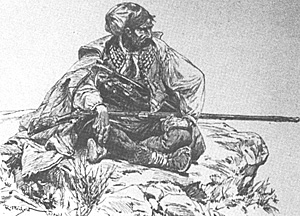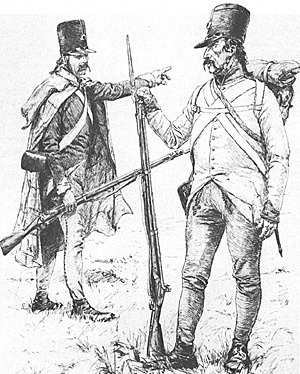Officially, in 1792 each Regiment
was to provide a total of about 2,900 men
for field service, (about 1,300 men per
battalion plus auxiliaries), plus artillery,
with about 400 men per Landes-Defension
Division. The reality was somewhat,
different - the numbers were so low that at
first, only two composite battalions could
be raised with six more in 1794-5.
[20]
In total, only about 13,000 men
fought in the Wars up to 1797. The
Grenzer fought well at Arcole and Rivoli in
November 1796, but the losses of that
Italian campaign were so heavy across the
whole army that most battalions were
down to around 100 men. The shortage of
weapons and equipment was so bad that
instead of muskets, only 6,000 pikes
could be provided for the Grenzer units.
Discipline likewise broke down during the
retreat - especially amongst Vlach Grenzer,
who instead of staying with the army in
April 1797, turned to pillaging the
townsfolk of Judenberg and had to be
rounded up by Austrian cavalry
detachments.
[21]
The War of the First Coalition
ended at the Peace of Campo Formio in
1797, where the ethnic cocktail was given
another stir. In return for the Austrian
Netherlands, (Belgium), the French handed
over the occupied Venetian Republic to
Imperial administration, together with its
possessions in Istria and Dalmatia. The
latter lay south of the Licca area, between
the coastal mountain range and the Adriatic
as far as Cattaro, (Kotor), but not including
the city state of Ragusa, (Dubrovnik).
[22]
Reference to the map will show
that the modern border of Croatia was thus
essentially established - albeit these new
territories were administered separately by
Austria until 1918 and the Grenz system
was not extended into them.
The coastal areas added a few
thousand Italians, 200,000 Croats and
50,000 Serbs to the Empire's population.
The Dalmatian Serbs were mainly
concentrated around Krun, just over the
border from the Licca Regiment, with its
own large Serb majority. Now known as
Knin, the town is the centre of the Serb self
proclaimed 'Republic of Krajina', scene of
recent heavy fighting, most prominently,
the neardestruction of a large dam in
January 1993.
The extension of the Habsburg
Empire as far as Cattaro also led to a flood
of Montenegrins joining the various Frei-
Korps - many seeking to gain Grenzer
status - and they were usually accepted on
presenting themselves at the border. [23]
The steady flow of Balkan refugees
threatened more problems as the pressure
on the available agricultural land grew, with
no means for the Austrians to gain more
other than a further clash with Turkey.
War broke out with France again in
1799, and with Turkey on their side, the
Austrians were able to raise nearly 30,000
men from the Grenz area - 36 battalions,
(Slavonia 10, Banat 5, Transylvania 5, the
western Districts 16), plus some
FreiKorps.
Twenty four Grenz battalions
served in Italy, the rest in Germany. Peace
again came at Luneville in early 1801 and as
the less- bellicose party at Court gained the
upper hand, it was time to take stock of the
Empire's forces. More than 100,000 Grenzer had fought in the ten-year period
of the wars, suffering 38,000 casualties.
Despite fighting bravely in Germany,
Switzerland and Italy, often in the difficult
rear-guard role, the military leadership felt
they had performed unevenly throughout.
Some Generals went so far as to call them
"shiftless, false and totally undisciplined".
[24]
Reinforcements had become an
increasing problem such that by early 1800,
replacements for casualties had to be found
in other non-German parts of the Empire.
Deteriorating conditions in the Grenz were
the main cause of a mutiny among two
Peterwardein battalions and the 12th
Hussars in July 1800.
Jugoslavia Part 2:
More Jugoslavia
 Devastated by crop failures in the
1780s and suffering heavy casualties in the
Turkish Wars of 1788-90, on the outbreak
of war with Revolutionary France, the
Grenz was not a happy place - even as late
as 1798, General De Vins reported
widespread destitution along the entire Frontier. [19]
Devastated by crop failures in the
1780s and suffering heavy casualties in the
Turkish Wars of 1788-90, on the outbreak
of war with Revolutionary France, the
Grenz was not a happy place - even as late
as 1798, General De Vins reported
widespread destitution along the entire Frontier. [19]
 Seressaner Scout
Seressaner Scout
 Pre 1798 sharpshooter in Feldmontur (left) and infantry in Hausmontur
Pre 1798 sharpshooter in Feldmontur (left) and infantry in Hausmontur
Croatia and the Habsburg Military Frontier
The Grenz and its Troops during the Revolutionary Wars to 1801
The Grenz 1801-1805 and the Serbian Revolt
The Grenz 1806 to 1809
Back to Napoleonic Notes and Queries #12 Table of Contents
Back to Age of Napoleon List of Issues
Back to MagWeb Master List of Magazines
© Copyright 1993 by Partizan Press.
This article appears in MagWeb.com (Magazine Web) on the Internet World Wide Web.
Other articles from military history and related magazines are available at http://www.magweb.com